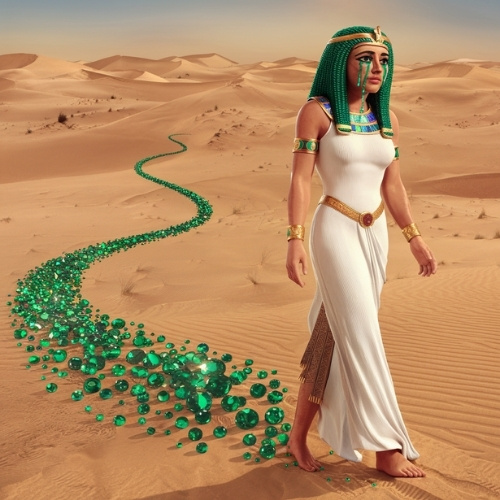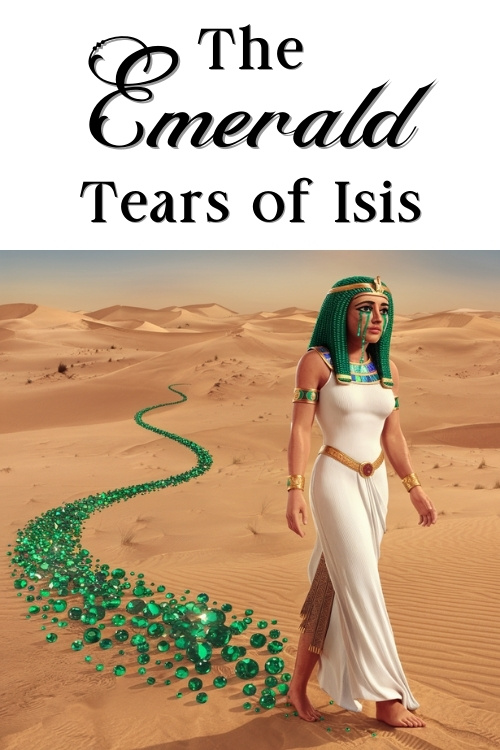Estimated reading time: 5 minutes
Ancient Egyptian mythology has no shortage of wonder. Gods walking among people, magic shaping the world, and celestial power guiding the balance of life. Among these stories, one legend is laden with emeralds: the Tears of Isis.
This myth speaks of grief so powerful it gave birth to emeralds themselves. As Isis mourned her beloved Osiris, her tears fell to the earth, and from them sprang brilliant green gems. From that moment on, emeralds were not only beautiful, they became symbols of love, loss, and rebirth.
The Legend of the Tears of Isis
Osiris was more than just a god. To the Egyptians, he was both divine and human. The first pharaoh, a wise and just ruler who guided his people with fairness. By his side was Isis, his queen and the goddess of magic, healing, and motherhood. Together they represented harmony and sacred rule.
But not everyone rejoiced in their unity. Osiris’s brother, Set, the god of disorder and storms, burned with jealousy. His envy grew into cruelty, and he plotted to take the throne for himself. In the ultimate betrayal, Set tricked Osiris into stepping into a beautifully decorated chest, slammed the lid shut, and threw it into the Nile.
The story only grows darker from there. When Osiris’s body was later found, Set tore it apart, scattering the pieces across Egypt to make sure his brother could never rise again. With Osiris gone, Set claimed the throne, plunging the land into turmoil.
Yet Isis refused to give in to her despair. With unshakable devotion, she searched every corner of Egypt to gather the fragments of Osiris, her grief fuelling her determination. In some tellings of the legend, it was during these sorrowful wanderings that her tears fell, turning into glowing emeralds where they touched the ground. Each gem shimmered with her love, pain, and hope.
Isis eventually found most of Osiris’ body with the help of her sister Nephthys. They pieced him back together, and using powerful magic, Isis returned her husband to life. Though he could no longer remain in the mortal world, before departing to rule the underworld, Isis and Osiris conceived their son, Horus, who would one day defeat his evil uncle, Set.
🔗Want to discover more about battle between Set and Horus? Read The Eye of Horus (coming soon)
Emeralds in Ancient Egypt
Long before other civilizations discovered their value, emeralds were treasured in Egypt. The oldest known mines, found in Wadi Sikait, were active as early as 330 BC. For the Egyptians, emerald’s lush green symbolised fertility, eternal youth, and prosperity. These gems adorned royal jewellery, protective amulets, and burial treasures meant to accompany the dead into the afterlife.
Few rulers are more famously linked to emeralds than Cleopatra. She adored them, claimed ownership of every emerald mine in Egypt, and gifted the gems to foreign dignitaries as glittering tokens of power and divine favour. But emeralds were more than just a symbol of wealth, they were sacred, mystical, and intimately tied to the gods.
Legends, like the Tears of Isis, connected emeralds directly to divine magic. Each stone was thought to shimmer with the love, grief, and devotion of the goddess herself. Priests and healers used emeralds in rituals to protect against evil, bless fertility, and inspire wisdom. The vibrant green of the gem was also linked to Horus, the falcon-headed son of Isis and Osiris, symbolising protection, victory, and the sky. Wearing an emerald was believed to bring clarity, truth, and glimpses of the divine.
Even in funerary practices, emeralds played a guiding role, accompanying the soul into the afterlife and supporting the promise of rebirth. In this way, emeralds were talismans of transformation, guardians of life, love, and renewal.
The Legacy of Isis’ Tears
Today, we know emeralds form through geological processes deep within the earth. Yet the legend of the Tears of Isis still lingers, adding an air of mystery and meaning that science alone can’t quite capture.
For jewellers, collectors, and anyone enchanted by mythology, the story breathes life into emeralds. Each green spark can be seen as a reminder of devotion, divine magic, and renewal, a goddess’s sorrow turned into everlasting beauty.
Just a quick side note – this tale of the Emerald Tears of Isis makes great marketing content, so feel free to retell it to your audience!
🔗 Want some guidance on using gemstone knowledge to market your jewellery business? Read Using Gemstone Knowledge to Boost Your Jewellery Sales
🔗Interested in exploring other emerald myths and legends? Emerald Myths and Legends
🛍️ Curious to find a pre-owned emerald for your next design? Check out what’s available.
📌 Save this legend of the Emerald Tears of Isis so you can easily find it again.


